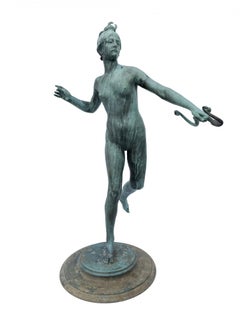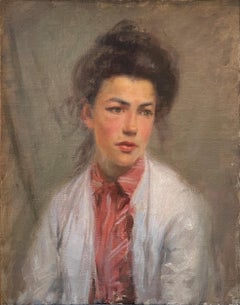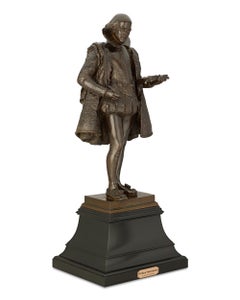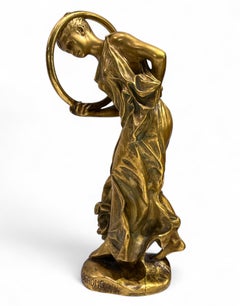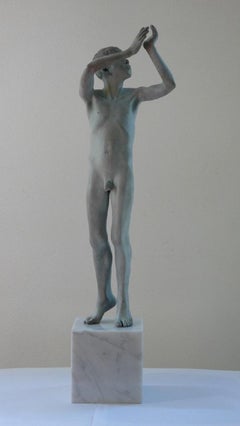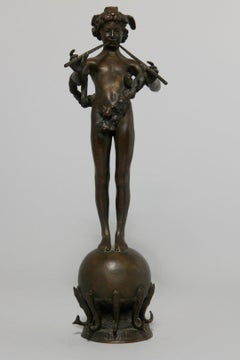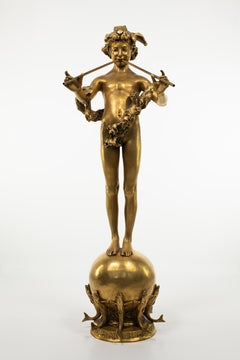Frederick William MacMonnies Art
American, 1863-1937
A sculptor of classical figures, American-born Frederick MacMonnies had fame in the United States and Europe in the later half of the 19th century and early 20th century. He occasionally returned to America but lived most of his life as in expatriate in France. He was especially known for his lithe bronze figures, especially ones titled Diana. The classical names of these figures allowed him the appearance of propriety but gave him the opportunity to model svelte nudes.
Frederick MacMonnies was one of the first American sculptors to recognize the potential market of the middle class. He copyrighted his works and then contracted with foundries to mass produce some of his figures such as Diana in smaller sizes.
MacMonnies was born in Brooklyn, New York, and was a child prodigy at carving stone. At age 18, he worked in the studio of Augustus Saint-Gaudens, and then persuaded him to become his assistant, keeping models damp and covered, running errands, and cleaning the studio. Evenings he studied at the Art Students League, Cooper Union, and the National Academy of Design.
In Saint-Gaudens' studio, he met many of the wealthy people who shared Saint-Gaudens Beaux-Arts based ideas that art and architecture should be unified in order to create public art in America equal to that of classical antiquity or Renaissance Europe. Among the men that MacMonnies met through Saint-Gaudens who later furthered his career were architects Stanford White and Charles McKim and John LaFarge, decorator of mansions of the wealthy including the Vanderbilts.
After four years of study and work in New York, MacMonnies left for Paris, opting for the more modernist techniques he could learn there over the more traditional sculpture teaching in Rome. One of his first teachers was Alexandre Falguiere, who had been an instructor of Saint-Gaudens and who injected a degree of contemporary realism into his classical figures. MacMonnies mingled with many upper class American expatriates and met his future wife, Mary Fairchild, a painter.
MacMonnies came home briefly to help Saint-Gaudens with a project and then gained admittance in Paris to the Ecole des Beaux Arts, where he did numerous classical figures inspired by the style of small bronzes of Renaissance Florence, Italy.
In 1889, he established his reputation with his sculpture of "Diana" at the Paris Salon. The execution of his nude sculpture was a challenge for a sculptor such as himself who strove for slim, well proportioned figures---the "aestheticizing of the nude". (Katz 12) In those days, most of the female models were poor peasants who were stocky with poor figures, distorted feet and often unbathed. However, MacMonnies found Marie Caira as the model for his Diana figures, and she, from a professional family of models, had the figure and social stature that met his criteria.
Although he chose to live in Paris, many of his public and private sculpture commissions in future years, with the help of Saint-Gaudens and also architect, Stanford White, were in the United States.to
1
2
1
Overall Width
to
Overall Height
to
2
2
1
1
1
1
4
3
3
2
1
1
1
1
1
2
2
1
1
1
4
9,162
2,694
1,353
1,352
1
4
Artist: Frederick William MacMonnies
Diana the Huntress, 1890 Classical Bronze Sculpture of Nude Woman
By Frederick William MacMonnies
Located in Beachwood, OH
Frederick William MacMonnies (American, 1863-1937)
Diana, 1890
Bronze with green verdigris patina
Signed and dated
Copyright 1894 with Jaboeuf & Rouard, Paris foundry mark
31 x 21 x 17 inches
A sculptor of classical figures, American-born Frederick MacMonnies...
Category
1890s Frederick William MacMonnies Art
Materials
Bronze
Model Study for Truth Sculpture at NY Public Library of Seated Man
By Frederick William MacMonnies
Located in Beachwood, OH
Frederick William MacMonnies (American, 1863-1937)
Model Study for Truth, c. 1910-14
Painted plaster
16.5 x 9.25 x 7.5 inches
For the 1920 sculpture for the New York Public Library
...
Category
1910s Frederick William MacMonnies Art
Materials
Plaster
"Marion Jones Farquhar" Frederick William Macmonnies, Tennis Olympian Portrait
By Frederick William MacMonnies
Located in New York, NY
Frederick William Macmonnies
Marion Jones Farquhar, 1905-11
Oil on canvas
24 x 20 inches
Provenance:
William Clerk
Private Collection, New York
Literature:
Mary Smart, A Flight with Fame: The Life and Art of Frederick MacMonnies, with a Catalogue Raisonne of Sculpture and a Checklist of Paintings by E. Adina Gordon, Madison, Connecticut, 1996, no. 90.
The work depicts Marion Jones Farquhar who, was an American tennis player who competed during the late 19th century and early 20th century. She won the singles titles at the 1899 and 1902 U.S championships and was the first American woman to medal at the Olympics placing Bronze in singles. Additionally, she was the artist's sister-in-law who often played and competed with MacMonnies in golf and tennis. MacMonnies would often study the movements of her form referenced in his sculpture. When MacMonnies won a doubles golf tournament he said "Marion dragged my dead weight thro' and won us the tournament, showing what great Generalship can do."
A sculptor of classical figures, American-born Frederick MacMonnies had fame in the United States and Europe in the later half of the 19th century and early 20th century. He occasionally returned to America but lived most of his life as in expatriate in France. He was especially known for his lithe bronze figures, especially ones titled Diana. The classical names of these figures allowed him the appearance of propriety but gave him the opportunity to model svelte nudes.
Frederick MacMonnies was one of the first American sculptors to recognize the potential market of the middle class. He copyrighted his works and then contracted with foundries to mass produce some of his figures such as Diana in smaller sizes.
MacMonnies was born in Brooklyn, New York, and was a child prodigy at carving stone. At age 18, he worked in the studio of Augustus Saint-Gaudens, and then persuaded him to become his assistant, keeping models damp and covered, running errands, and cleaning the studio. Evenings he studied at the Art Students League, Cooper Union, and the National Academy of Design.
In Saint-Gaudens' studio, he met many of the wealthy people who shared Saint-Gaudens Beaux-Arts based ideas that art and architecture should be unified in order to create public art in America equal to that of classical antiquity or Renaissance Europe. Among the men that MacMonnies met through Saint-Gaudens who later furthered his career were architects Stanford White and Charles McKim...
Category
Early 1900s American Impressionist Frederick William MacMonnies Art
Materials
Canvas, Oil
Patinated Bronze Statuette of William Shakespeare
By Frederick William MacMonnies
Located in New Orleans, LA
Frederick William MacMonnies
1863–1937 American
William Shakespeare
Signed "F. MacMonnies" and foundry-marked "E. Gruet Jeune, Fondeur, Paris"
Bronze
Frederick William MacMonnies...
Category
19th Century Academic Frederick William MacMonnies Art
Materials
Bronze
Related Items
Jean-Léon Gérôme La Danseuse au Cerceau - Gilt Bronze Statue of a Hoop Dancer
By Jean-Léon Gérôme
Located in New York, NY
Jean-Léon Gérôme
French
1824 - 1904
La Joueuse De Cerceau - The Hoop Dancer
A mini gilt bronze female figural statue of a young hoop dancer inspired by a trove of ancient terraco...
Category
19th Century Academic Frederick William MacMonnies Art
Materials
Bronze
$5,500
H 9 in W 3.5 in D 5 in
Gallulus Bronze Sculpture Nude Boy Male Figure Green Patina Marble Stone
By Wim van der Kant
Located in Utrecht, NL
Gallulus Bronze Sculpture Nude Boy Male Figure Green Patina Marble Stone
Wim van der Kant (1949, Kampen) is a selftaught artist. Next to his busy profess...
Category
21st Century and Contemporary Contemporary Frederick William MacMonnies Art
Materials
Marble, Bronze
$9,643
H 16.54 in W 7.88 in
Take Me Home, 12x8" oil, framed
By Lu Haskew
Located in Loveland, CO
"Take me Home" by Lu Haskew
Oil 19x16" framed, 12x8" image size
Signed lower left
A young child very apparently ready to go home from their intense yet cute look. The child is weari...
Category
Early 2000s American Impressionist Frederick William MacMonnies Art
Materials
Canvas, Oil
Contemporary Sculpture Hybrid Animal Bright Blue Orange Plaster Acrylic
By Polly Little
Located in Buffalo, NY
Hybrid II by Polly Little (2022). Plaster and acrylic paint.
Category
2010s Contemporary Frederick William MacMonnies Art
Materials
Plaster, Acrylic
$200
H 10 in W 8 in D 5 in
Bufo Contemporary Bronze Sculpture Nude Boy Marble Stone Male Figure
By Wim van der Kant
Located in Utrecht, NL
Bufo Contemporary Bronze Sculpture Nude Boy Marble Stone Male Figure
Wim van der Kant (1949, Kampen) is a selftaught artist. Next to his busy profession as a teacher at a high school, he intensively practises his profession as a sculptor. Only when his work would measure up to his own standards, he decided to present it to the rest of the world. In 1995, he exhibited for the first time with Morren Galleries. Van der Kant desires to sculpt young people who still stand uninhibited and curiously in life. The reason he chooses to sculpt boys is, because he is one himself, this way the subject is closer to him. The anatomy of his figures testify of perfectionism. Van der Kant's subjects show similarities with the sculptures from the Greek and Roman antiquity...
Category
21st Century and Contemporary Contemporary Frederick William MacMonnies Art
Materials
Marble, Bronze
$10,706
H 12.21 in W 7.88 in
The Comedy
Located in PARIS, FR
Pierre-Marie POISSON (1876-1953)
The Comedy
Bronze sculpture with black patina
signed on the base "P. Poisson"
Cast by Valsuani (with the foundry stamp)
Raised on a stone base
Fra...
Category
1930s French School Frederick William MacMonnies Art
Materials
Bronze
Polo Player Bookends in Bronze
Located in Brookville, NY
Polo Bookends in bronze for the sporty library. These were purchased from the collection of a polo player on Long Island who had a beautiful library of sporting books. He also owne...
Category
1960s Academic Frederick William MacMonnies Art
Materials
Bronze
Fleur – Charlotte by Nando Kallweit. Elegant bronze figurative sculpture
By Nando Kallweit
Located in Coltishall, GB
Fleur – Charlotte is an elegant figurative bronze sculpture by Nando Kallweit.
Inspired by the the legend of the phoenix, this female figure has graceful wings instead of arms. The...
Category
21st Century and Contemporary Other Art Style Frederick William MacMonnies Art
Materials
Bronze
$1,616
H 11.82 in W 2.56 in D 4.73 in
Woman's Chest - Bronze Sculpture by Aurelio Mistruzzi
Located in Roma, IT
Edition of 100 copies numbered and signed by the artist.
Excellent conditions.
Aurelio Mistruzzi was an Italian sculptor and medalist.
He attended the Udine ...
Category
1930s Frederick William MacMonnies Art
Materials
Bronze
$7,123 Sale Price
30% Off
H 14.97 in W 5.91 in D 12.21 in
Eduardo Paolozzi: 'Fist' plaster sculpture
By Sir Eduardo Paolozzi
Located in London, GB
To see our other Modern British Art, scroll down to "More from this Seller" and below it click on "See all from this Seller" - or send us a message if you cannot find the artist you ...
Category
1990s Modern Frederick William MacMonnies Art
Materials
Plaster
Woman Seated A Bronze Sculpture of a Woman by Charles Rumsey
By Charles Cary Rumsey
Located in Brookville, NY
The bronze sculpture of a woman by Charles Rumsey is undated, but was created at a point in his career where he began to transition from realism to more modern, looser depictions of ...
Category
1920s American Modern Frederick William MacMonnies Art
Materials
Bronze
$6,000
H 10.5 in W 11 in D 6 in
'I Like When You Call Me Senhorita' III (Orig. Female Bust With Real Seashells)
By Mauro Oliveira
Located in LOS ANGELES, CA
**FALL SUPER SALE TIL OCT. 13TH - TAKE ADVANTAGE OF IT**
The Senhorita Bust Series by Mauro Oliveira. Each one is one of a kind in colors and original seashells head arrangement.
>...
Category
21st Century and Contemporary Contemporary Frederick William MacMonnies Art
Materials
Resin, Plaster, Wood, Glue, Acrylic
$1,200 Sale Price
40% Off
H 20 in W 11 in D 6 in
Previously Available Items
Pan of Rohallion, 1889-90 classical bronze sculpture
By Frederick William MacMonnies
Located in Beachwood, OH
Frederick W. MacMonnies (American, 1863-1937)
Pan of Rohallion, 1889-90 (Garden 22)
Bronze
Signed on base, 'ROMAN BRONZE WORKS NY' at base
14.25 x 4 x 6 inches
A sculptor of classical figures, American-born Frederick MacMonnies...
Category
1880s Frederick William MacMonnies Art
Materials
Bronze
H 14.25 in W 4 in D 6 in
Gold, Pan of Rohallion, Bronze, Sculpture
By Frederick William MacMonnies
Located in New York, NY
This rare model of MacMonnies Pan of Rohallion is done in gilt patina instead of a dark patina. A great bronze and very famous model it would be a stu...
Category
1890s Romantic Frederick William MacMonnies Art
Materials
Bronze
Frederick William Macmonnies art for sale on 1stDibs.
Find a wide variety of authentic Frederick William MacMonnies art available for sale on 1stDibs. You can also browse by medium to find art by Frederick William MacMonnies in bronze, metal and more. Not every interior allows for large Frederick William MacMonnies art, so small editions measuring 4 inches across are available. Customers who are interested in this artist might also find the work of Bela Bacsi, Doris Caesar, and Margot Homan. Frederick William MacMonnies art prices can differ depending upon medium, time period and other attributes. On 1stDibs, the price for these items starts at $7,000 and tops out at $40,500, while the average work can sell for $23,750.
